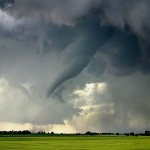 Tornadoes spawned within the outer rainbands of landfalling tropical cyclones regularly pose a great threat to coastal regions. These tornadoes, while less intense than there Great Plains counterparts, can still cause considerable loss of live and property damage. In fact, between 1970 and 2020, tornadoes were responsible for ~5% of all deaths and ~13% of the total insured damage caused by landfalling hurricanes along U.S. coasts. Much of the challenge faced by forecasters is to identify which convective cells will become tornadic out of the hundreds that often move onshore. If common distinguishing features of the tornadic cells can be identified while the cells are still offshore and non-tornadic, then forecasters may be able to increase their lead time and better forewarn the public. Current research efforts are also directed toward better understanding the various mechanisms and conducive environments that lead to supercell and tornado formation in the rainbands of landfalling tropical cyclones. Our primary approach is through extensive analysis of aircraft and land-based observations (e.g., Doppler radar, GPS dropwinsondes, rawinsondes, and traditional flight-level data).
Tornadoes spawned within the outer rainbands of landfalling tropical cyclones regularly pose a great threat to coastal regions. These tornadoes, while less intense than there Great Plains counterparts, can still cause considerable loss of live and property damage. In fact, between 1970 and 2020, tornadoes were responsible for ~5% of all deaths and ~13% of the total insured damage caused by landfalling hurricanes along U.S. coasts. Much of the challenge faced by forecasters is to identify which convective cells will become tornadic out of the hundreds that often move onshore. If common distinguishing features of the tornadic cells can be identified while the cells are still offshore and non-tornadic, then forecasters may be able to increase their lead time and better forewarn the public. Current research efforts are also directed toward better understanding the various mechanisms and conducive environments that lead to supercell and tornado formation in the rainbands of landfalling tropical cyclones. Our primary approach is through extensive analysis of aircraft and land-based observations (e.g., Doppler radar, GPS dropwinsondes, rawinsondes, and traditional flight-level data).
The overall objective of this study is two-fold: (1) document the structure of multiple offshore convective cells within outer TC rainbands to determine the frequency and structure of offshore supercells, and (2) document significant differences between tornadic and non-tornadic soundings in onshore and near-shore environments of landfalling TC with the goal of developing new TC-specific parameters for forecasting tornado potential.
This line of research has been primarily funded through grants from UNC Charlotte with additional support from the Federal Alliance for Home Safety and the NOAA Hurricane Research Division.
Relevant Publications and Presentations:
Eastin, M.D., and M.C. Link, 2009: Miniature supercells in an offshore outer rainband of Hurricane Ivan (2004). Monthly Weather Review, 137, 2081-2014.
Baker, A.K., M.D. Parker, and M.D. Eastin, 2009: Environmental ingredients for supercells and tornadoes within Hurricane Ivan. Weather and Forecasting, 24, 223-244.
Caylor, J., 2025: The offshore to onshore transition of near-surface winds in landfalling hurricanes. M.S. Thesis, UNC Charlotte. (Advisor: M.D. Eastin)
Toadvine, M., 2022: An updated climatology of tornadoes spawned by landfalling tropical cyclones. M.S. Thesis, UNC Charlotte. (Advisor: M.D. Eastin)
Eastin, M.D., M.C. Link, and C. Self, 2014: An updated tropical cyclone tornado parameter for use in situational awareness forecasting. 31st AMS Conference on Hurricanes and Tropical Meteorology, San Diego, CA, American Meteorological Society
Eastin, M.D., and A. Picard, 2014: Analysis of miniature supercells observed in the outer rainbands of Hurricane Gustav (2008). 31st AMS Conference on Hurricanes and Tropical Meteorology, San Diego, CA, American Meteorological Society
Eastin, M.D., 2011: Doppler-derived thermodynamic structure of miniature supercells observed in the rainbands of Hurricanes Ivan and Gustav. 35th AMS Radar Meteorology Conference, Pittsburgh, PA, American Meteorological Society